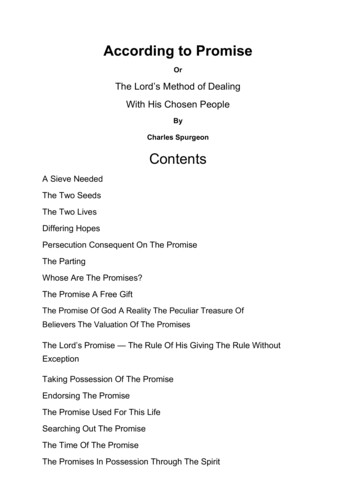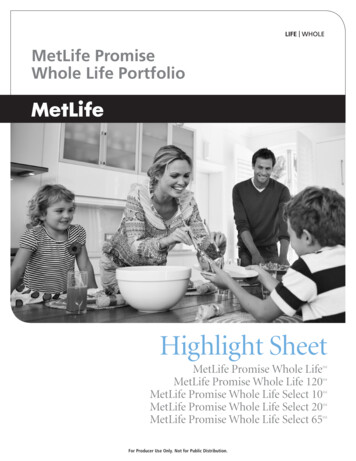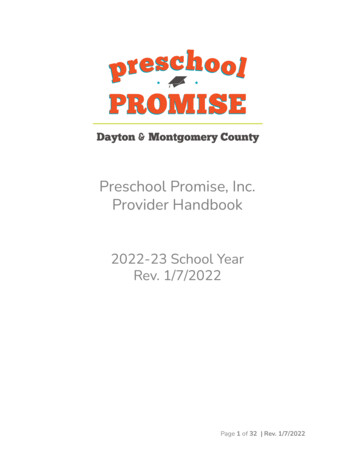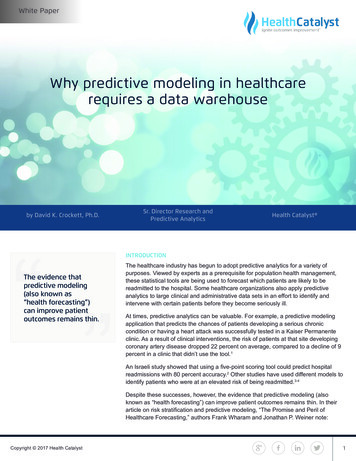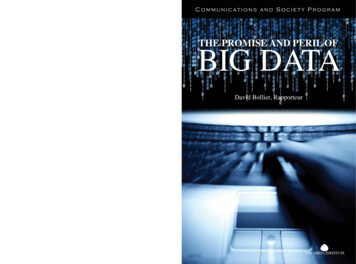
Transcription
Communications and Society ProgramBollierTHE PROMISE AND PERIL OF BIG DATAPublications OfficeP.O. Box 222109 Houghton Lab LaneQueenstown, MD 2165810-001BIG DATATHE PROMISE AND PERIL OFDavid Bollier, Rapporteur
The Promise and Perilof Big DataDavid BollierRapporteurCommunications and Society ProgramCharles M. FirestoneExecutive DirectorWashington, DC2010
To purchase additional copies of this report, please contact:The Aspen InstitutePublications OfficeP.O. Box 222109 Houghton Lab LaneQueenstown, Maryland 21658Phone: (410) 820-5326Fax: (410) 827-9174E-mail: publications@aspeninstitute.orgFor all other inquiries, please contact:The Aspen InstituteCommunications and Society ProgramOne Dupont Circle, NWSuite 700Washington, DC 20036Phone: (202) 736-5818Fax: (202) 467-0790Charles M. FirestonePatricia K. KellyExecutive DirectorAssistant DirectorCopyright 2010 by The Aspen InstituteThis work is licensed under the Creative Commons AttributionNoncommercial 3.0 United States License. To view a copy of thislicense, visit r send a letter to Creative Commons, 171 Second Street,Suite 300, San Francisco, California, 94105, USA.The Aspen InstituteOne Dupont Circle, NWSuite 700Washington, DC 20036Published in the United States of America in 2010by The Aspen InstituteAll rights reservedPrinted in the United States of AmericaISBN: 0-89843-516-110-0011762/CSP/10-BK
ContentsForeword, Charles M. Firestone. viiThe Promise and Peril of Big Data, David BollierHow to Make Sense of Big Data?. 3Data Correlation or Scientific Models?. 4How Should Theories be Crafted in an Age of Big Data?. 7Visualization as a Sense-Making Tool. 9Bias-Free Interpretation of Big Data?. 13Is More Actually Less?. 14Correlations, Causality and Strategic Decision-making. 16Business and Social Implications of Big Data. 20Social Perils Posed by Big Data. 23Big Data and Health Care. 25Big Data as a Disruptive Force (Which is therefore Resisted). 28Recent Attempts to Leverage Big Data. 29Protecting Medical Privacy. 31How Should Big Data Abuses be Addressed?. 33Regulation, Contracts or Other Approaches?. 35Open Source Analytics for Financial Markets?. 37Conclusion . . 40AppendixRoundtable Participants. 45About the Author. 47Previous Publications from the Aspen InstituteRoundtable on Information Technology. 49About the Aspen InstituteCommunications and Society Program. 55
This report is written from the perspective of an informed observer at theEighteenth Annual Aspen Institute Roundtable on Information Technology.Unless attributed to a particular person, none of the comments or ideas containedin this report should be taken as embodying the views or carrying the endorsementof any specific participant at the Conference.
ForewordAccording to a recent report1, the amount of digital content on theInternet is now close to five hundred billion gigabytes. This numberis expected to double within a year. Ten years ago, a single gigabyte ofdata seemed like a vast amount of information. Now, we commonlyhear of data stored in terabytes or petabytes. Some even talk of exabytesor the yottabyte, which is a trillion terabytes or, as one website describesit, “everything that there is.”2The explosion of mobile networks, cloud computing and new technologies has given rise to incomprehensibly large worlds of information, often described as “Big Data.” Using advanced correlation techniques, data analysts (both human and machine) can sift through massive swaths of data to predict conditions, behaviors and events in waysunimagined only years earlier. As the following report describes it:Google now studies the timing and location of searchengine queries to predict flu outbreaks and unemployment trends before official government statistics comeout. Credit card companies routinely pore over vastquantities of census, financial and personal information to try to detect fraud and identify consumer purchasing trends.Medical researchers sift through the health records ofthousands of people to try to identify useful correlationsbetween medical treatments and health outcomes.Companies running social-networking websites conduct “data mining” studies on huge stores of personalinformation in attempts to identify subtle consumerpreferences and craft better marketing strategies.A new class of “geo-location” data is emerging thatlets companies analyze mobile device data to make1. See -digital-universe/iview.htm.2. See http://www.uplink.freeuk.com/data.html.vii
viiiThe Promise and Peril of Big Dataintriguing inferences about people’s lives and theeconomy. It turns out, for example, that the length oftime that consumers are willing to travel to shoppingmalls—data gathered from tracking the location ofpeople’s cell phones—is an excellent proxy for measuring consumer demand in the economy.But this analytical ability poses new questions and challenges. Forexample, what are the ethical considerations of governments or businesses using Big Data to target people without their knowledge? Doesthe ability to analyze massive amounts of data change the natureof scientific methodology? Does Big Data represent an evolution ofknowledge, or is more actually less when it comes to information onsuch scales?The Aspen Institute Communications and Society Program convened 25 leaders, entrepreneurs, and academics from the realms oftechnology, business management, economics, statistics, journalism,computer science, and public policy to address these subjects at the2009 Roundtable on Information Technology.This report, written by David Bollier, captures the insights from thethree-day event, exploring the topic of Big Data and inferential softwarewithin a number of important contexts. For example: Do huge datasets and advanced correlation techniques meanwe no longer need to rely on hypothesis in scientific inquiry? When does “now-casting,” the search through massive amountsof aggregated data to estimate individual behavior, go over theline of personal privacy? How will healthcare companies and insurers use the correlations of aggregated health behaviors in addressing the futurecare of patients?The Roundtable became most animated, however, and found thegreatest promise in the application of Big Data to the analysis of systemic risk in financial markets.
Foreword ixA system of streamlined financial reporting, massive transparency,and “open source analytics,” they concluded, would serve better thanpast regulatory approaches. Participants rallied to the idea, furthermore, that a National Institute of Finance could serve as a resource forthe financial regulators and investigate where the system failed in oneway or another.AcknowledgementsWe want to thank McKinsey & Company for reprising as the seniorsponsor of this Roundtable. In addition, we thank Bill Coleman,Google, the Markle Foundation, and Text 100 for sponsoring this conference; James Manyika, Bill Coleman, John Seely Brown, Hal Varian,Stefaan Verhulst and Jacques Bughin for their suggestions and assistancein designing the program and recommending participants; StefaanVerhulst, Jacques Bughin and Peter Keefer for suggesting readings; andKiahna Williams, project manager for the Communications and SocietyProgram, for her efforts in selecting, editing, and producing the materialsand organizing the Roundtable; and Patricia Kelly, assistant director, forediting and overseeing the production of this report.Charles M. FirestoneExecutive DirectorCommunications and Society ProgramWashington, D.C.January 2010
The Promise and Peril of Big DataDavid Bollier
The Promise and Perilof Big DataDavid BollierIt has been a quiet revolution, this steady growth of computing anddatabases. But a confluence of factors is now making Big Data a powerful force in its own right.Computing has become ubiquitous, creating countless new digital puddles, lakes, tributaries and oceans of information. A menagerie of digital devices has proliferated and gonemobile—cell phones, smart phones, laptops, a radicallypersonal sensors—which in turn are generatinga daily flood of new information. More busi- new kind ofness and government agencies are discovering “knowledgethe strategic uses of large databases. And as all infrastructure”these systems begin to interconnect with eachis materializing.other and as powerful new software tools andtechniques are invented to analyze the data A new era offor valuable inferences, a radically new kind of Big Data is“knowledge infrastructure” is materializing. A emerging .new era of Big Data is emerging, and the implications for business, government, democracyand culture are enormous.Computer databases have been around for decades, of course. What isnew are the growing scale, sophistication and ubiquity of data-crunchingto identify novel patterns of information and inference. Data is not justa back-office, accounts-settling tool any more. It is increasingly used as areal-time decision-making tool. Researchers using advanced correlationtechniques can now tease out potentially useful patterns of informationthat would otherwise remain hidden in petabytes of data (a petabyte is anumber starting with 1 and having 15 zeros after it).Google now studies the timing and location of search-engine queries to predict flu outbreaks and unemployment trends before official1
2The Promise and Peril of Big Datagovernment statistics come out. Credit card companies routinely poreover vast quantities of census, financial and personal information to tryto detect fraud and identify consumer purchasing trends.Medical researchers sift through the health records of thousands ofpeople to try to identify useful correlations between medical treatmentsand health outcomes.Companies running social-networking websites conduct “data mining” studies on huge stores of personal information in attempts to identify subtle consumer preferences and craft better marketing strategies.A new class of “geo-location” data is emerging that lets companiesanalyze mobile device data to make intriguing inferences about people’slives and the economy. It turns out, for example, that the length of timethat consumers are willing to travel to shopping malls—data gatheredfrom tracking the location of people’s cell phones—is an excellentproxy for measuring consumer demand in the economy.The inferential techniques being used on Big Data can offer greatinsight into many complicated issues, in many instances with remarkable accuracy and timeliness. The quality of business decision-making,government administration, scientific research and much else canpotentially be improved by analyzing data in better ways.But critics worry that Big Data may be misused and abused, and thatit may give certain players, especially large corporations, new abilitiesto manipulate consumers or compete unfairly in the marketplace. Dataexperts and critics alike worry that potential abuses of inferential datacould imperil personal privacy, civil liberties and consumer freedoms.Because the issues posed by Big Data are so novel and significant,the Aspen Institute Roundtable on Information Technology decidedto explore them in great depth at its eighteenth annual conference. Adistinguished group of 25 technologists, economists, computer scientists, entrepreneurs, statisticians, management consultants and otherswere invited to grapple with the issues in three days of meetings, fromAugust 4 to 7, 2009, in Aspen, Colorado. The discussions were moderated by Charles M. Firestone, Executive Director of the Aspen InstituteCommunications and Society Program. This report is an interpretivesynthesis of the highlights of those talks.
The Report3How to Make Sense of Big Data?To understand implications of Big Data, it first helps to understandthe more salient uses of Big Data and the forces that are expandinginferential data analysis. Historically, some of the most sophisticatedusers of deep analytics on large databases have been Internet-basedcompanies such as search engines, social networking websites andonline retailers. But as magnetic storage technologies have gottencheaper and high-speed networking has made greater bandwidthmore available, other industries, government agencies, universities andscientists have begun to adopt the new data-analysis techniques andmachine-learning systems.Certain technologies are fueling the use of inferential data techniques.New types of remote censors are generating new streams of digital datafrom telescopes, video cameras, traffic monitors, magnetic resonanceimaging machines, and biological and chemical sensors monitoring theenvironment. Millions of individuals are generating roaring streams ofpersonal data from their cell phones, laptops, websites and other digitaldevices.The growth of cluster computing systems and cloud computingfacilities are also providing a hospitable context for the growth ofinferential data techniques, notes computer researcher Randal Bryantand his colleagues.1 Cluster computing systems provide the storagecapacity, computing power and high-speed local area networks tohandle large data sets. In conjunction with “new forms of computationcombining statistical analysis, optimization and artificial intelligence,”writes Bryant, researchers “are able to construct statistical models fromlarge collections of data to infer how the system should respond tonew data.” Thus companies like Netflix, the DVD-rental company,can use automated machine-learning to identify correlations in theircustomers’ viewing habits and offer automated recommendations tocustomers.Within the tech sector, which is arguably the most advanced user ofBig Data, companies are inventing new services such that give drivingdirections (MapQuest), provide satellite images (Google Earth) andconsumer recommendations (TripAdvisor). Retail giants like WalMart assiduously study their massive sales databases—267 milliontransactions a day—to help them devise better pricing strategies, inventory control and advertising campaigns.
4The Promise and Peril of Big DataIntelligence agencies must now contend with a flood of data from its ownsatellites and telephone intercepts as well as from the Internet and publications. Many scientific disciplines are becoming more computer-based anddata-driven, such as physics, astronomy, oceanography and biology.Data Correlation or Scientific Models?As the deluge of data grows, a key question is how to make senseof the raw information. How can researchers use statistical tools andcomputer technologies to identify meaningful patterns of information?How shall significant correlations of data be interpreted? What is therole of traditional forms of scientific theorizing and analytic models inassessing data?Chris Anderson, the Editor-in-Chief of Wired magazine, ignited asmall firestorm in 2008 when he proposed that “the data deluge makesthe scientific method obsolete.”2 Anderson argued the provocativecase that, in an age of cloud computing and massive datasets, the realchallenge is not to come up with new taxonomies or models, but to siftthrough the data in new ways to find meaningful correlations.At the petabyte scale, information is not a matter ofsimple three and four-dimensional taxonomy andorder but of dimensionally agnostic statistics. It callsfor an entirely different approach, one that requiresus to lose the tether of data as something that can bevisualized in its totality. It forces us to view data mathematically first and establish a context for it later. Forinstance, Google conquered the advertising world withnothing more than applied mathematics. It didn’t pretend to know anything about the culture and conventions of advertising—it just assumed that better data,with better analytic tools, would win the day. AndGoogle was right.Physics and genetics have drifted into arid, speculative theorizing,Anderson argues, because of the inadequacy of testable models. Thesolution, he asserts, lies in finding meaningful correlations in massivepiles of Big Data, “Petabytes allow us to say: ‘Correlation is enough.’We can stop looking for models. We can analyze the data without
The Report5hypotheses about what it might show. We can throw the numbers intothe biggest computing clusters the world has ever seen and let statisticalalgorithms find patterns where science cannot.”J. Craig Venter used supercomputers and statistical methods to findmeaningful patterns from shotgun gene sequencing, said Anderson.Why not apply that methodology more broadly? He asked, “Correlationsupersedes causation, and science can advance even without coherentmodels, unified theories, or really any mechanistic explanation at all.There’s no reason to cling to our old ways. It’s time to ask: What canscience learn from Google?”Conference participants agreed that there is a lot of useful information to be gleaned from Big Data correlations. But there was a strongconsensus that Anderson’s polemic goes too far. “Unless you create amodel of what you think is going to happen, you can’t ask questionsabout the data,” said William T. Coleman. “You have to have somebasis for asking questions.”Researcher John Timmer put it succinctly in an article at the ArsTechnica website, “Correlations are a way of catching a scientist’sattention, but the models and mechanisms that explain them are howwe make the predictions that not only advance science, but generatepractical applications.”3Hal Varian, Chief Economist at Google, agreed with that argument,“Theory is what allows you to extrapolate outside the observed domain.When you have a theory, you don’t want to test it by just looking at thedata that went into it. You want to make some new prediction that’simplied by the theory. If your prediction is validated, that gives yousome confidence in the theory. There’s this old line, ‘Why does deduction work? Well, because you can prove it works. Why does inductionwork? Well, it’s always worked in the past.’”Extrapolating from correlations can yield specious results even iflarge data sets are used. The classic example may be “My TiVO ThinksI’m Gay.” The Wall Street Journal once described a TiVO customerwho gradually came to realize that his TiVO recommendation systemthought he was gay because it kept recommending gay-themes films.When the customer began recording war movies and other “guy stuff”in an effort to change his “reputation,” the system began recommending documentaries about the Third Reich.4
6The Promise and Peril of Big DataAnother much-told story of misguided recommendations basedon statistical correlations involved Jeff Bezos, the founder of Amazon.To demonstrate the Amazon recommendation engine in front of anaudience, Bezos once called up his own set of recommendations. Tohis surprise, the system’s first recommendation was Slave Girls fromInfinity—a choice triggered by Bezos’ purchase of a DVD of Barbarella,the Jane-Fonda-as-sex-kitten film, the week before.Using correlations as the basis for forecasts can be slippery for otherreasons. Once people know there is an automated system in place, theymay deliberately try to game it. Or they may unwittingly alter theirbehavior.It is the “classic Heisenberg principle problem,” said Kim Taipale,the Founder and Executive Director of the Center for Advanced Studiesin Science and Technology. “As soon as you put up a visualization ofdata, I’m like—whoa!—I’m going to ‘Google bomb’ those questions sothat I can change the outcomes.” (“Google bombing” describes concerted, often-mischievous attempts to game the search-algorithm of theGoogle search engine in order to raise the ranking of a given page in thesearch results.5)The sophistication of recommendation-engines is improving allthe time, of course, so many silly correlations may be weeded out inthe future. But no computer system is likely to simulate the level ofsubtlety and personalization that real human beings show in dynamicsocial contexts, at least in the near future. Running the numbers andfinding the correlations will never be enough.Theory is important, said Kim Taipale, because “you have to havesomething you can come back to in order to say that something is rightor wrong.” Michael Chui, Senior Expert at McKinsey & Company,agrees: “Theory is about predicting what you haven’t observed yet.Google’s headlights only go as far as the data it has seen. One way tothink about theories is that they help you to describe ontologies thatalready exist.” (Ontology is a branch of philosophy that explores thenature of being, the categories used to describe it, and their orderedrelationships with each other. Such issues can matter profoundly whentrying to collect, organize and interpret information.)Jeff Jonas, Chief Scientist, Entity Analytic Solutions at the IBMSoftware Group, offered a more complicated view. While he agrees
The Report7that Big Data does not invalidate the need for theories and models,Jonas believes that huge datasets may help us “find and see dynamically changing ontologies without having to try to prescribe them inadvance. Taxonomies and ontologies are things that you might discover by observation, and watch evolve over time.”John Clippinger, Co-Director of the Law Lab at Harvard University,said: “Researchers have wrestled long and hard with language andsemantics to try to develop some universal ontologies, but they havenot really resolved that. But it’s clear that you have to have someunderlying notion of mechanism. That leads me to think that theremay be some self-organizing grammars that have certain properties tothem—certain mechanisms—that can yield certain kinds of predictions. The question is whether we can identify a mechanism that is richenough to characterize a wide range of behaviors. That’s somethingthat you can explore with statistics.”How Should Theories be Crafted in an Age of Big Data?If correlations drawn from Big Data are suspect, or not sturdyenough to build interpretations upon, how then shall society constructmodels and theories in the age of Big Data?Patrick W. Gross, Chairman of the Lovell Group, challenged theeither/or proposition that either scientific models or data correlationswill drive future knowledge. “In practice, the theory and the data reinforce each other. It’s not a question of data correlations versus theory.The use of data for correlations allows one to test theories and refinethem.”That may be, but how should theory-formation proceed in lightof the oceans of data that can now be explored? John Seely Brown,Independent Co-Chair of Deloitte Center for the Edge, believes that wemay need to devise new methods of theory formation: “One of the bigproblems [with Big Data] is how to determine if something is an outlieror not,” and therefore can be disregarded. “In some ways, the moredata you have, the more basis you have for deciding that somethingis an outlier. You have more confidence in deciding what to knockout of the data set—at least, under the Bayesian and correlational-typetheories of the moment.”
8The Promise and Peril of Big DataBut this sort of theory-formation is fairly crude in light of the keenand subtle insights that might be gleaned from Big Data, said Brown:“Big Data suddenly changes the whole game of how you look at theethereal odd data sets.” Instead of identifying outliers and “cleaning”datasets, theory formation using Big Data allows you to “craft an ontology and subject it to tests to see what its predictive value is.”He cited an attempt to see if a theory could be devised to compress theEnglish language using computerized, inferential techniques. “It turnsout that if you do it just right—if you keep words as words—you cancompress the language by x amount. Butif you actually build a theory-formation“ The more datasystem that ends up discovering the morthere is, the better my phology of English, you can radicallycompress English. The catch was, how dochances of findingyou build a machine that actually starts tothe ‘generators’ for ainvent the ontologies and look at what itnew theory.”can do with those ontologies?”Before huge datasets and computingJohn Seely Brownpower could be applied to this problem,researchers had rudimentary theoriesabout the morphology of the English language. “But now that we have‘infinite’ amounts of computing power, we can start saying, ‘Well, maybethere are many different ways to develop a theory.’”In other words, the data once perceived as “noise” can now be reconsidered with the rest of the data, leading to new ways to developtheories and ontologies. Or as Brown put it, “How can you invent the‘theory behind the noise’ in order to de-convolve it in order to find thepattern that you weren’t supposed to find? The more data there is, thebetter my chances of finding the ‘generators’ for a new theory.”Jordan Greenhall suggested that there may be two general ways todevelop ontologies. One is basically a “top down” mode of inquirythat applies familiar philosophical approaches, using a priori categories.The other is a “bottom up” mode that uses dynamic, low-level dataand builds ontologies based on the contingent information identifiedthrough automated processes.For William T. Coleman, the real challenge is building new types ofmachine-learning tools to help explore and develop ontologies: “We
The Report9have to learn how to make data tagged and self-describing at some level.We have to be able to discover ontologies based on the questions andproblems we are posing.” This task will require the development ofnew tools so that the deep patterns of Big Data can be explored moreflexibly yet systematically.Bill Stensrud, Chairman and Chief Executive Officer of InstantEncore,a website that connects classical music fans with their favorite artists,said, “I believe in the future the big opportunity is going to be nonhuman-directed efforts to search Big Data, to find what questions canbe asked of the data that we haven’t even known to ask.”“The data is the question!” Jeff Jonas said. “I mean that seriously!”Visualization as a Sense-Making ToolPerhaps one of the best tools for identifying meaningful correlationsand exploring them as a way to develop new models and theories, iscomputer-aided visualization of data. Fernanda B. Viégas, ResearchScientist at the Visual Communications Lab at IBM, made a presentation that described some of the latest techniques for using visualizationto uncover significant meanings that may be hidden in Big Data.Google is an irresistible place to begin such an inquiry because it hasaccess to such massive amounts of timely search-query data. “Is Googlethe ultimate oracle?” Viégas wondered. She was intrigued with “GoogleSuggest,” the feature on the Google search engine that, as you type inyour query, automatically lists the most-searched phrases that beginwith the words entered. The feature serves as a kind of instant aggregator of what is on people’s minds.Viégas was fascinated with people using Google as a source of practical advice, and especially with the types of “why?” questions that theyasked. For example, for people who enter the words “Why doesn’the ” will get Google suggestions that complete the phrase as “Whydoesn’t he call?”, “Why doesn’t he like me?” and “Why doesn’t he loveme?” Viégas wondered what the corresponding Google suggestionswould be for men’s queries, such as “Why doesn’t she ?” Viégas foundthat men asked similar questions, but with revealing variations, such as“Why doesn’t she just leave?”
10The Promise and Peril of Big DataViégas and her IBM research colleague Martin Wattenberg developed a feature that visually displays the two genders’ queries side byside, so that the differences can be readily seen. The program, now inbeta form, is meant to show how Google data can be visually depictedto help yield interesting insights.While much can be learned by automating the search process forthe data or by “pouring” it into a useful visual format, sometimes ittakes active human interpretation to spot the interesting patterns. Forexample, researchers using Google Earth maps made a striking discovery—that two out of three cows (based on a sample of 8,510 cattle in 308herds from around the world) align their bodies with the magnetic northof the Earth’s magnetic field.6 No machine would have been capable ofmaking this starting observation as something worth investigating.Viégas offered other arresting examples of how the visualization ofdata can reveal interesting patterns, which in turn can help researchers develop new models and theories. Can the vast amount of datacollected by remote sensors yield any useful patterns that might serveas building blocks for new types of knowledge? This is one hope for“smart dust,” defined at Wikipedia as a “hypothetical wireless networkof tiny mic
THE PROMISE AND PERIL OF BIG DATA Publications Office P.O. Box 222 109 Houghton Lab Lane Queenstown, MD 21658 10-001 Communications and Society Program . John Seely Brown, Hal Varian, Stefaan Verhulst and Jacques Bughin for their suggestions and assistance in designing the program and recommending participants; Stefaan Verhulst, Jacques .




